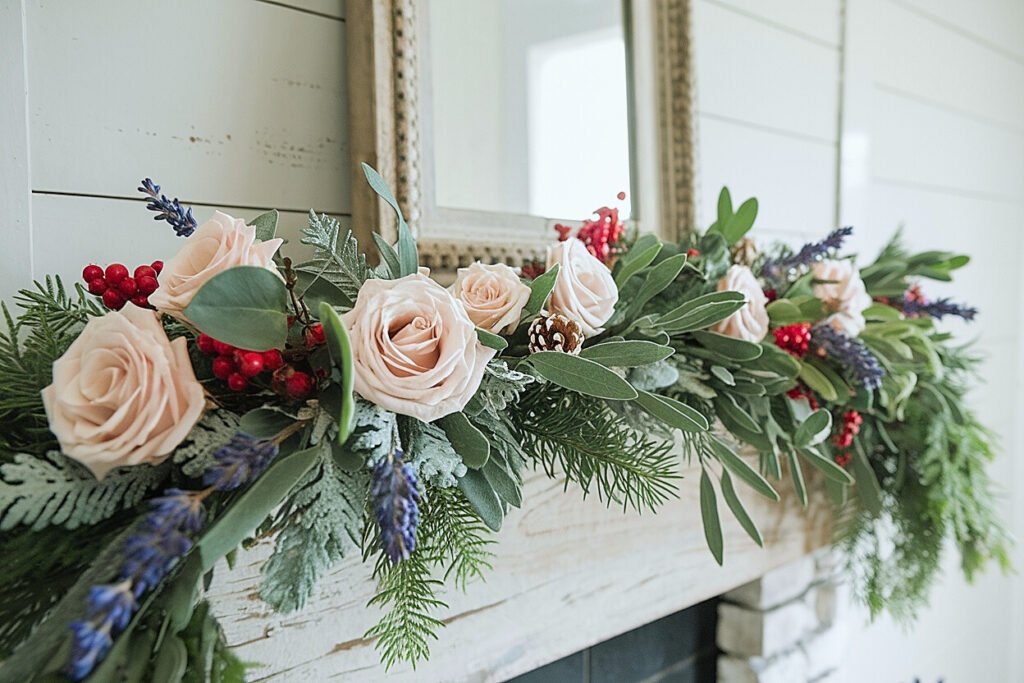
This website contains affiliate links, and some products are gifted by the brand to test. As an Amazon Associate, I earn from qualified purchases. Some of the content on this website was researched and created with the assistance of AI technology.
Key Takeaways
- A standout garland comes from smart choices: sturdy base greens, fragrant lavender, and roses that hold form.
- Work in layers—greens → structure → focal roses → lavender → accents (lights, ornaments, ribbon).
- Keep stems short, wire everything, and balance both sides visually.
- Choose light types and ribbon widths that match the scale of your space.
- Hydration hacks and smart placement help your garland look fresh from Advent to New Year’s.
I build Christmas garlands the same way I plate holiday food: generous, thoughtful, and with a pinch of drama. If you’ve ever wondered how to create a Lavender and Rose Christmas Garland that actually lasts and smells incredible, you’re in the right place. I’ll walk you through the exact steps I use on client installs—no fluff, just results.
The big idea is simple. Mix the romance of roses with the calm of lavender, then anchor everything with winter greens. When you understand how line, texture, and fragrance work together, your garland stops looking like a craft project and starts reading like a designer statement. That’s the difference friends notice the second they walk in.
You’ll see how I select rose varieties, wire stems, layer textures, and sneak in tiny lights without turning the whole thing into a tangle. We’ll cover ornaments, ribbon strategies, color schemes, table-runner tricks, snow-kissed details, and—most important—how to keep it fresh through the entire season. By the end, how to create a Lavender and Rose Christmas Garland will feel second nature.
| 🎨 Color Palette | 🌿 Floral Combination | ✨ Decorative Elements | 🎄 Placement & Styling Tips |
|---|---|---|---|
| Soft blush, lavender purple, antique gold | English roses, dried lavender, seeded eucalyptus | Gold mercury glass votives, velvet ribbons | Ideal for Christmas dining tables; use low arrangements to keep sightlines clear |
| Ivory, lavender grey, deep plum | White roses, lavender sprigs, dusty miller | Frosted pinecones, pearl garlands | Perfect for mantel displays; mix varying heights for dimension |
| Pale pink, lavender, champagne | Garden roses, dried lavender, white hypericum berries | Glass cloches, micro-LED fairy lights | Beautiful for coffee tables; layer fairy lights inside cloches for a magical glow |
| Mauve, soft cream, sage green | Cream roses, French lavender, silver brunia | Woven wicker baskets, linen runners | Ideal for rustic farmhouse kitchens; pair with warm candlelight |
| Dusty rose, lilac, matte silver | David Austin roses, dried lavender buds, lamb’s ear | Silver chargers, lace table overlays | Works beautifully for formal holiday dinners; coordinate with silverware and crystal glassware |
💡 Pro Tip: Lavender’s cool tones calm vibrant Christmas reds and golds, creating balance. Pair with warm metallics or natural textures for a holiday look that feels fresh and timeless.
How to Choose the Perfect Roses for Your Christmas Garland
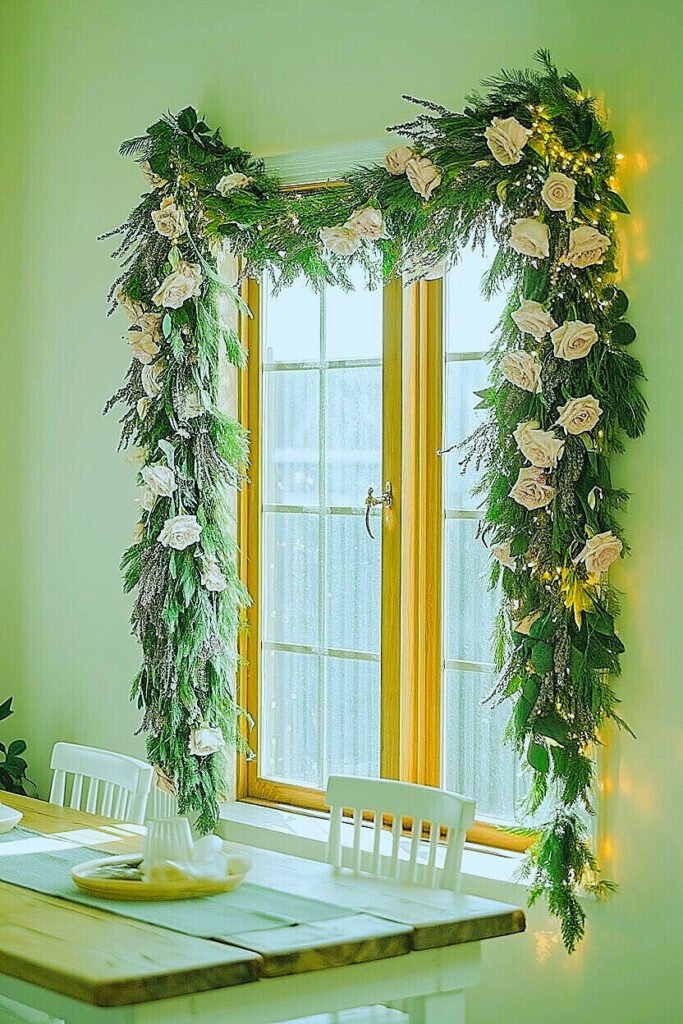
The right roses carry your garland. I look for faces that read instantly from six feet away, plus petals that don’t bruise if you so much as breathe on them. Garden roses bring volume and nostalgia, while spray roses give rhythm and fill. For durability, I lean into varieties with thicker petals and strong necks—think David Austin–style rosettes or sturdy hybrid teas cut short.
Color matters just as much as form. Soft pinks, shell blush, or icy lavender echo the cool tones of winter, while deep claret roses land like velvet against frosted greens. If you need staying power, preserved and high-quality faux stems can mingle with fresh heads. No one will know once you blend textures and keep your cuts tight.
Quick comparison
| Rose Type | Look | Strengths | Watch-outs |
|---|---|---|---|
| Garden (cabbage/English) | Big rosette | Showstopper blooms | Shorter vase life if overheated |
| Spray roses | Multiple small heads | Filler + rhythm | Smaller focal impact |
| Hybrid tea | Classic cup | Strong stems | Can read formal if overused |
| Preserved | “Forever” look | Zero wilting | Matte finish—layer with fresh |
| High-end faux | Perfect faces | Budget-friendly long term | Mix with fresh to avoid flatness |
How I pick and prep
- Choose 2–3 rose types: one focal (garden/rosette), one secondary (spray), one optional filler (hybrid tea).
- Hydrate overnight in cool water.
- Cut stems very short (1.5–2 in / 4–5 cm) for wiring.
- Wire through calyx with floral wire; tape stems with floral tape for grip.
- Stage roses in breathable boxes until placement.
To go deeper into petal firmness, color undertones, and how I pair fresh with preserved, keep moving—there’s more nuance ahead.
If you’re also mixing dried elements this season, my short guide on using dried lavender in Thanksgiving centerpieces has tips that translate perfectly to Christmas work—feel free to share this post with a friend who’d love a calmer, scented holiday home.
What Are the Best Greens to Pair with Lavender and Rose Christmas Garlands?
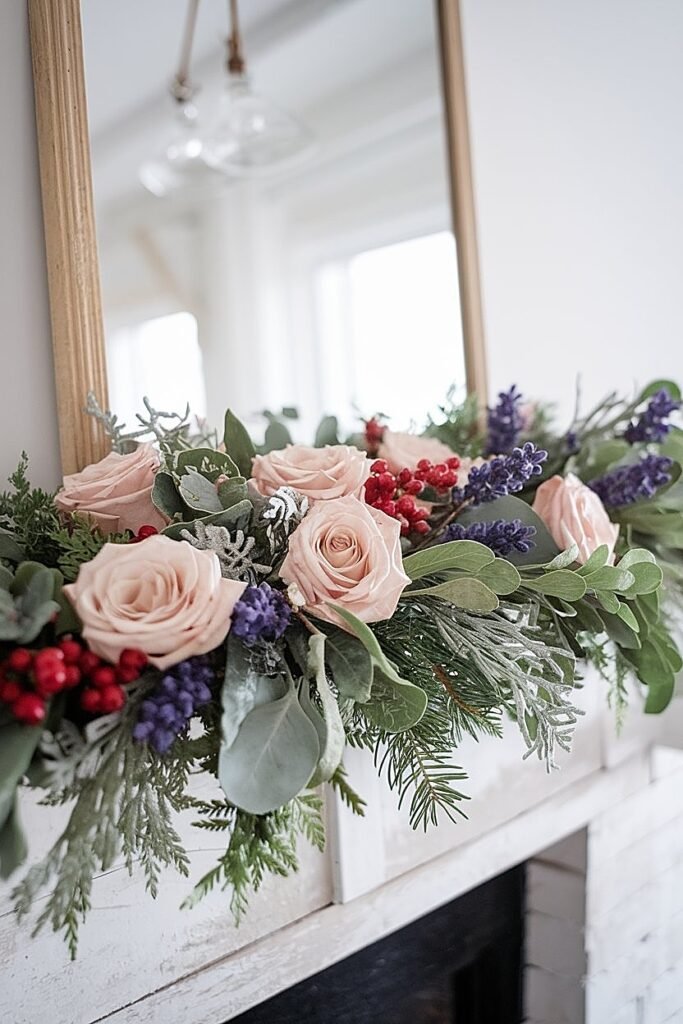
A garland lives or dies by its base. I start with a spine of durable evergreens—something that can carry weight, hide mechanics, and hold moisture. Then I blend finer textures so roses and lavender don’t fight a single, flat green. Contrast is the magic: broad, glossy, feathery, and needle-fine.
Below are five greens I reach for when roses and lavender are the stars. Each one contributes structure or fragrance—or both. Use two for backbone and one or two for texture changes. That’s the sweet spot.
The 5 Best Greens
- Noble Fir
Noble fir gives you a strong, flexible base that won’t crumble when you wire heavy rose clusters. Its blue-green tone cools the palette, which flatters lavender and blush roses instantly. The needles lock into floral wire without slipping. Because it’s slow to shed, your garland looks crisp longer, especially near fireplaces or doorways. I use it as the main “spine,” then tuck lighter textures on top. If you want staying power and clean lines, start with Noble. - Cedar (Incense or Port Orford)
Cedar drapes. It softens the fir’s structure and adds movement that reads luxe in every room. The fan-like sprays hide mechanics and catch fairy lights beautifully. Cedar also carries a cozy, resinous scent that pairs well with the herbal note of lavender. It does dry a bit faster than fir near heat, so I mist it lightly every couple of days. Use it as a secondary layer from midline downward to create that expensive “waterfall” effect. - Eucalyptus (Seeded or Silver Dollar)
Eucalyptus brings bluish tone and round leaf shapes that play perfectly with cupped rose faces. Seeded eucalyptus contributes dotted texture that feels festive without ornaments. It drinks well, but leaves can curl if air gets too hot; keep a small mister handy. I like it in small, repeating clusters along the garland, especially near focal roses. The aroma nudges the lavender’s calm vibe forward, making the entire room feel like a winter spa rather than a pine forest. - Boxwood
Boxwood is a stealth hero in mixed garlands. Tight leaves fill gaps that would otherwise show wire or foam, and the glossy surface throws gentle highlights under warm lights. It’s also surprisingly sturdy once hydrated, resisting sag when roses go in. I tuck boxwood as “plugs” where the base looks thin, then echo it along the top edge for a manicured finish. If you want a refined, dressed look around stair rails or mantels, boxwood does that elegantly. - Juniper (with Berries)
Juniper adds delicate needles and dusty blue berries that echo lavender’s color family. Those tiny orbs look like installed ornaments without buying extra decor. It dries gracefully, so the look stays pretty even as the weeks pass. Place juniper in visual “pockets” near rose clusters where you want quiet sparkle. Because branches can be brittle, pre-wire small tufts rather than forcing large stems into the base. It’s the finishing brushstroke that makes the composition sing.
How I layer greens
- Build a fir spine; secure with cable ties or paddle wire.
- Cascade cedar to soften edges.
- Add small eucalyptus and boxwood clusters where needed.
- Finish with juniper tufts around focal points.
Want to see how I scale greens for doors versus mantels and stairs? Keep going—loads of tactical detail ahead.
How to Incorporate Lights into Your Christmas Garland Design
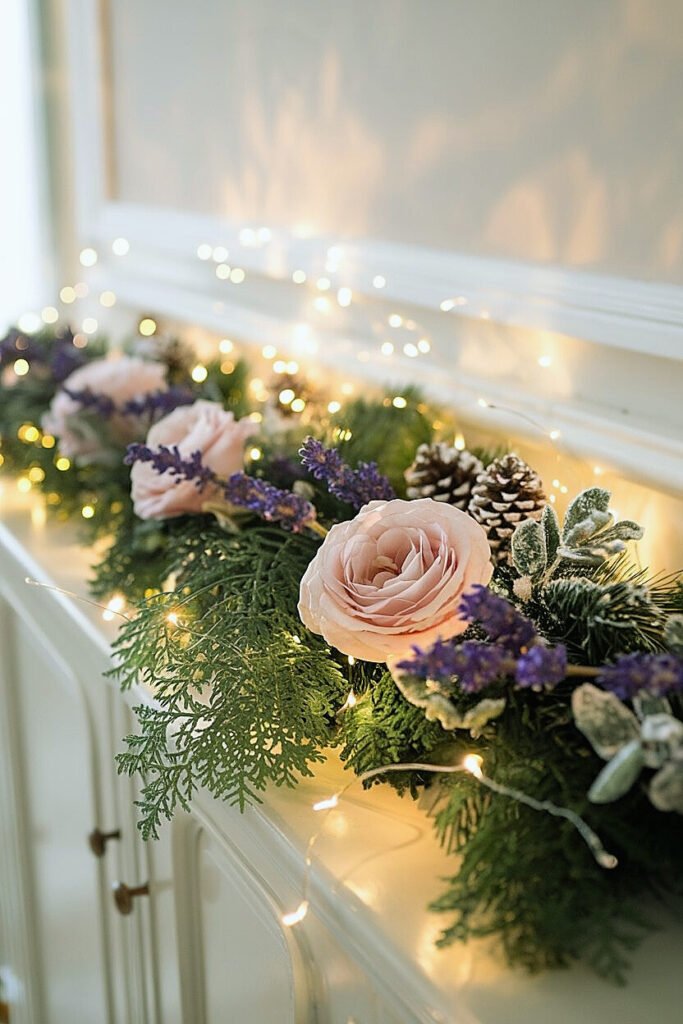
Lights should whisper, not shout. I choose micro-LED strings on thin wire so the glow hugs the greens and disappears during the day. Warm white reads candlelit; cool white leans frosty. Battery packs save outlets on mantels, but plug-in strands make sense for long stair runs.
A trick from event work: light the base before roses and lavender. That way you never crush petals reaching for a hidden switch. I tuck the wire deep, then pull a few bulbs forward like stars.
Light options at a glance
| Use Case | Type | Why It Works |
|---|---|---|
| Mantels / small spaces | Battery micro-LED | No cords; hide pack behind stocking or candle |
| Long banisters | Plug-in micro-LED | Continuous power; dimmer compatible |
| Outdoor frames | Outdoor-rated LED string | Weatherproof; sturdier wire |
| Table runners | Copper wire fairy lights | Flexible; easy to snake between stems |
Placement steps
- Test all strands.
- Weave lights along the fir spine first.
- Hide battery packs in a vented, non-heat pocket; secure with Velcro.
- After flowers go in, pull a few bulbs forward around focal roses.
- Set on a timer so you never fish around at bedtime.
If you’re curious how I match color temperature to rose palettes, keep reading—the next sections unpack it.
Ways to Add Ornaments to a Lavender and Rose Christmas Garland
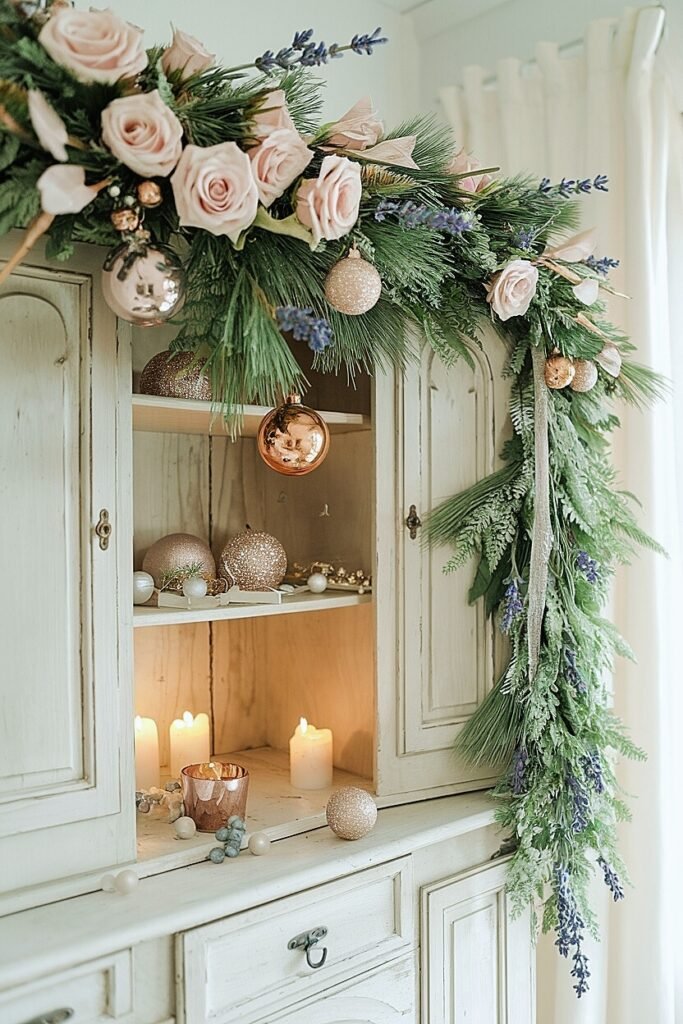
Ornaments should support the flowers, not overpower them. I like matte, brushed metallics, or mercury glass for quiet shimmer. Smaller sizes (1–2 in / 2.5–5 cm) keep proportions right; jumbo baubles can work, but I cluster them lower in the garland so they don’t visually outweigh the roses.
Use ornament hooks only as a last resort. I prefer wiring each ornament with 26–28 gauge floral wire, then anchoring to the garland frame. It’s faster than it sounds and much more secure.
5 Best Ways to Add Ornaments
- Cluster Trios Near Focal Roses
Group three small ornaments—matte, satin, and mercury—in a tight triangle 2–3 inches from a focal rose. The mixed finishes bounce light without stealing attention from petals. Wire each through the cap and twist to a single stem pick, then anchor that pick into the garland’s spine. This method installs quickly, prevents dangles, and gives a tailored, designer look. Use one trio per 18–24 inches to create a gentle rhythm down the garland. - Berry-Style Ornament Sprays
Thread tiny bead ornaments onto thin wire to make your own “sprays.” Each spray adds fine sparkle in the same scale as juniper berries or seeded eucalyptus. Tuck these behind lavender sprigs so the light hits both surfaces. Sprays are perfect for filling narrow visual gaps where a full ball won’t fit. Because they’re lightweight, they won’t shift as the garland settles, keeping the composition crisp even after a week on the wall. - Mercury Glass Drops at the Edge
Hang teardrop or icicle ornaments from the lower edge where drape occurs. The elongated shape echoes cedar’s fall and draws the eye downward, making the whole installation feel taller and more elegant. Use subtle, smoked silver rather than chrome so the tone doesn’t fight rose color. Wire directly to the base rather than a twig tip; that way they don’t swing wildly when doors open or someone brushes the banister. - Velvet-Wrapped Mini Balls
Wrap small balls in scraps of velvet ribbon that match your chosen bow color. The soft surface pairs beautifully with garden roses and reads “old-world” without feeling heavy. Because velvet absorbs light, it brings compositional balance if your garland has a lot of metallics elsewhere. Glue the velvet seam on the “back” and wire the ornament in at a slight angle, so the texture faces outward. Great trick when you need warmth fast. - Frosted Glass Near Lights
Place frosted or opal glass ornaments adjacent to micro-LED bulbs. The glass diffuses the point light into a halo that softens the whole scene. Keep these pieces small and sparse—too many, and you lose definition. I install them near transitions (ends, corners, mantel brackets) where a gentle glow helps the eye travel. They double as tiny, built-in light diffusers, which is handy when your strands are a touch brighter than planned.
Ornament rule of thirds
- One accent trio per 18–24 in.
- Drops only on the lower edge.
- Keep 70% matte/satin, 30% metallic.
Want advanced cluster maps for stair turns and mantel corners? Stick with me—the ribbon strategy is coming up.
Ways to Add Ribbons to a Lavender and Rose Christmas Garland for a Festive Touch
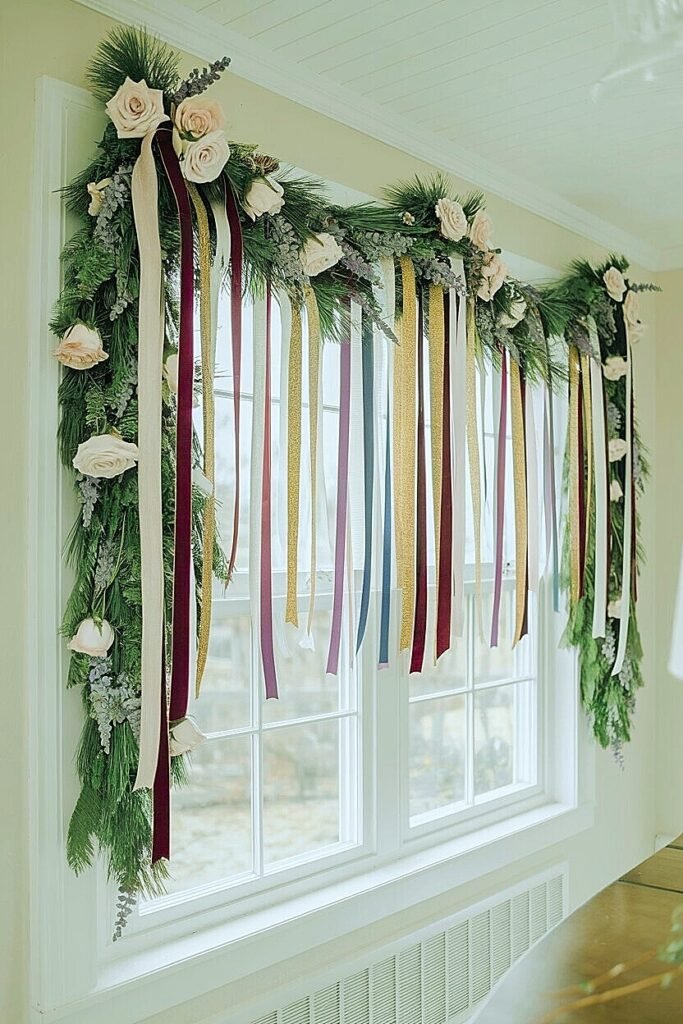
Ribbon sets the mood—formal, romantic, or playful—without piling on ornaments. I mix widths (1”, 1.5”, 2.5”) and textures (velvet, silk, gauze) to echo the roses. Lavender and rose palettes love soft fabrics; metallics work best as slender accents rather than wide statement bows.
I never run one long ribbon from end to end. Instead, I cut shorter lengths and “tuck and loop” them, which keeps tension consistent and makes repairs easy if a section shifts.
7 Best Ribbon Approaches
- Nested Loops
Create two or three loops of different widths nested together, then wire the cluster where you’d place a focal rose. The stack reads sculptural and repeats along the garland without looking like gift bows. Use velvet for the largest loop, silk for the medium, and organza for the smallest. The layered translucency brings depth in low light and photographs beautifully. Nesting also prevents floppy ends that can hide roses or catch on passing sleeves. - Trailing Tails at the Ends
Reserve long, romantic tails for the garland tips. Cut on a diagonal and let them drape 12–18 inches beyond the greenery. The movement leads the eye into the room and frames the installation. I pick velvet or double-faced satin here because ends get touched; sturdier ribbon keeps edges clean. If you have pets or small kids, secure the last inch with a hidden micro-clip so tails look free but stay put. - Figure-Eight Tucks
Cut 12–14 inch pieces and fold each into a loose figure-eight. Wire at the center, then tuck into the garland near secondary roses. This adds repeated shape without obvious bows, and it’s fast to scale across a long banister. The figure-eight also echoes the rosette form of garden roses subconsciously, which is why it feels harmonious even when viewers can’t say why. I use this method when I want rhythm more than drama. - Ribbon Over-Under Weave
Weave a 1.5” silk ribbon shallowly through the fir spine, popping out every 8–10 inches. It acts like a soft guideline for the eye and hides cable ties. Keep tension light so the weave doesn’t cut into greens. This approach is subtle but powerful; it visually organizes ornaments and lights while letting roses and lavender stay central. Choose a tone close to your greens or a gentle metallic for a quiet sheen. - Micro-Ribbon Accents
Add ¼–½” metallic cord in short, 4–6 inch lengths around lavender sprigs. These read like jewelry, catching light without crowding petals. Because they’re tiny, you can use more of them without heaviness. I wire them to lavender stems before placing that bundle into the garland, which speeds installation. They’re also great for “rescuing” dull pockets when you step back and see an area that needs a lift but not a full ornament cluster. - Asymmetric Statement Bow
Place a single, larger bow off-center—about one-third from an end—then balance with smaller loops elsewhere. This keeps the look editorial instead of formal. I choose crinkled silk or hand-dyed velvet for texture depth, keeping tails short so roses remain the stars. The asymmetry mirrors how we compose floral arrangements, which makes the garland feel designed, not mass-produced. It’s also a strong photo anchor for the inevitable holiday family shot. - Double-Sided Color Play
Use ribbon that’s one color on each side (lavender face, silver reverse). Twist slightly when creating loops so both hues show. This introduces motion and dimension without adding more elements. It’s perfect when your rose palette straddles cool and warm tones and you need a bridge. Keep twists consistent directionally so the visual flow stays tidy. The result? A nuanced, high-end look with almost no extra time.
My ribbon ratio
- 60% soft textures (velvet/silk), 40% sheer/metallic accents.
- Loops every 16–20 in; tails only at ends.
Curious how ribbon color links to rose palettes? Next up we’ll talk color schemes that never miss.
How to Layer Textures in Your Lavender and Rose Christmas Garland
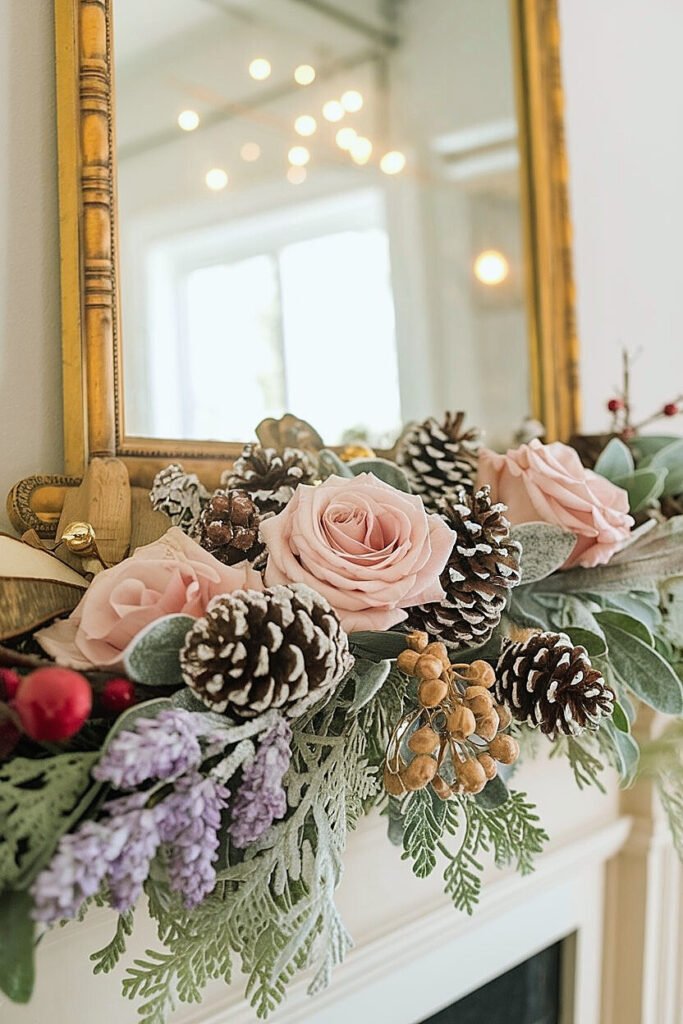
Texture is how you make people want to touch your garland. Start with the contrast between needles (fir/juniper), fans (cedar), rounds (eucalyptus), and tight leaves (boxwood). Then add floral texture: plush garden roses against crisp spray roses and feathery dried lavender.
I keep textures in “families.” Soft with soft, crisp with crisp, then cross them at focal points. That way nothing feels random, but the whole still reads rich.
Solution: Three-layer map
- Structure: fir + cedar set the silhouette.
- Floral: garden roses as anchors; spray roses as bridges.
- Aroma/Detail: lavender sprigs + juniper berries + micro-ribbon.
If you want exact stem counts for a 6-foot mantel vs. a 14-step staircase, keep reading—I’ll give durability tricks at the end.
What Are the Best Rose Color Schemes for a Christmas Garland?
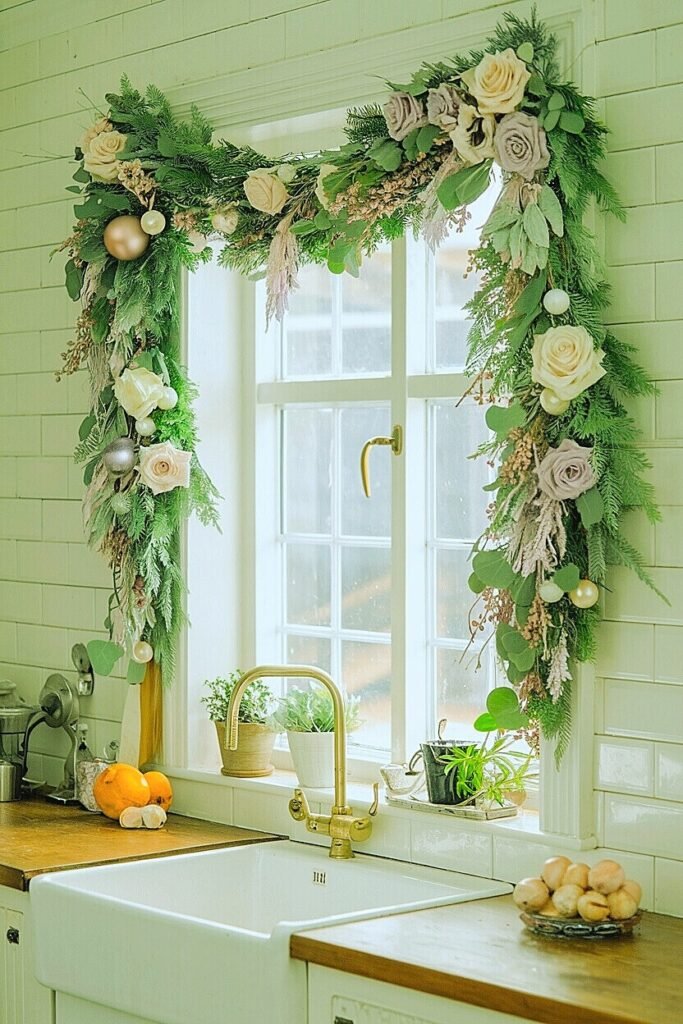
Color sets the story. Do you want snowfall romance or hearth-side warmth? Below are five palettes that never fail with lavender in the mix. Each scheme plays differently under warm vs. cool lights, which is why pre-testing with your actual bulbs saves headaches later.
5 Winning Color Schemes
- Icy Blush + Lavender + Silver
Pair pale blush garden roses with lavender spray roses and silver micro-accents. Under warm LED, blush stays delicate instead of turning peach. Silver ornaments and mercury glass keep the palette crisp. Add eucalyptus and juniper to echo the cool notes. This scheme suits modern spaces and white fireplaces; it photographs with a clean, editorial feel. If you love a snow-kissed look without stark white roses, this mix delivers high romance with a quiet winter glow. - Mulled Wine + Mauve + Soft Lavender
Deep claret roses anchor the design; mauve spray roses bridge to lavender. The mood is moody without going gothic. Choose bronze or smoked gold ornaments to warm the scene, and slip in cedar to add motion. Under candlelight or warm micro-LED, the claret reads velvety and the lavender keeps it from feeling heavy. This palette is fantastic for dark wood mantels and rooms with vintage brass—old-world charm without the stuffiness. - Cream + Dusty Pink + French Lavender
Cream roses make lavender look luminous. Dusty pink becomes the mediator, softening transitions between cool and warm undertones. Use boxwood for polish and keep ornaments matte to preserve the softness. Copper micro-ribbon adds just enough glow. This mix works beautifully on staircase banisters where daylight changes throughout the day; it remains pretty in both morning cool light and evening warm light. Think “winter sunrise” in flower form. - Snow White + Heather + Chrome
For a crisp, minimal interior, go white garden roses, heather-tinged lavender sprigs, and touches of chrome. Keep greenery tight and architectural—fir, boxwood, a hint of eucalyptus. Under cool white LEDs, everything feels crystalline. The key is restraint: fewer ornaments, more negative space, and micro-ribbon rather than broad bows. If your living room runs Scandinavian or contemporary, this palette reads intentional and sharp, the floral equivalent of a fresh snowfall on stone. - Vintage Rose Mix + Plum + Pewter
Blend antique pink garden roses with plum spray roses and pewter accents. It’s nostalgic in the best way—soft, layered, and cozy. Cedar adds movement; juniper’s dusty berries tie to pewter ornaments. Under mixed light, the pewter hue avoids the brass vs. chrome fight, keeping everything cohesive. This scheme thrives in homes with collected decor and eclectic art, where you want warmth and story rather than strict minimalism or high shine.
Solution: Color selection steps
- Choose a base (cool vs. warm) to match your room’s lighting.
- Pick three rose tones: focal, bridge, accent.
- Match metals to temperature (silver/chrome for cool, bronze/pewter for warm).
Want a cheat sheet for bulb Kelvin values against each palette? Keep rolling—the table-runner section shows practical staging.
How to Use a Lavender and Rose Garland as a Christmas Table Runner
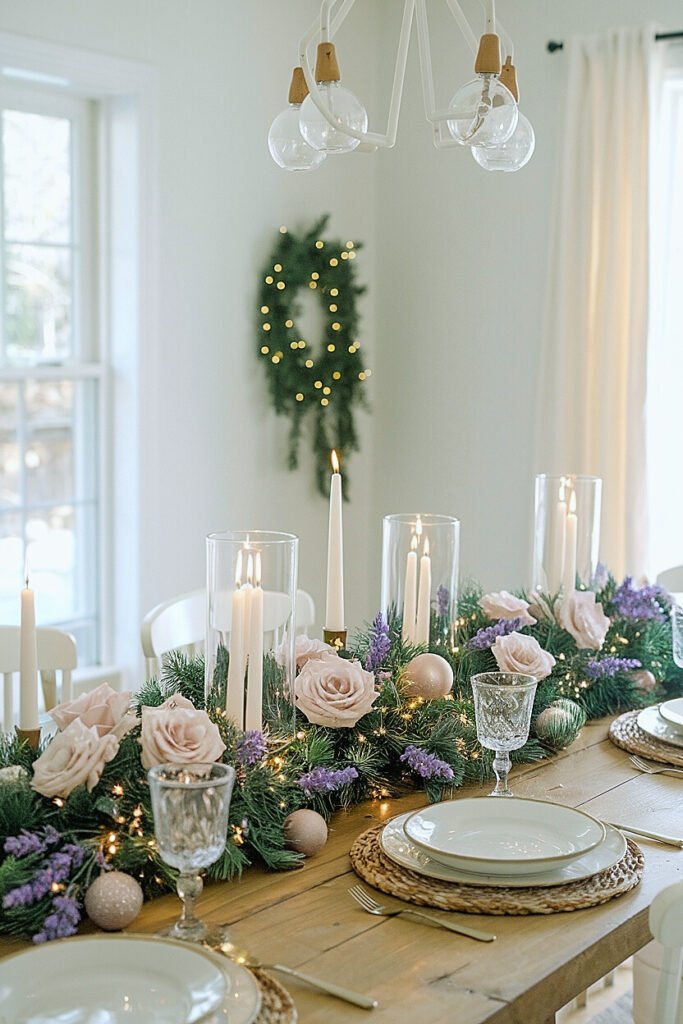
A garland table runner turns dinner into theater. Keep the profile low so guests can see across the table. I build on a narrow runner board (a 4–6 in / 10–15 cm strip of thin plywood or foam) lined with damp floral wrap. That protects the table and makes cleanup painless.
Spacing is everything. Alternate rose clusters with open green patches every 12 inches, then stitch in lavender where the eye needs a pause. Small, low votives replace tall tapers so petals don’t scorch.
Table staging
- Pre-build the garland on a board near the table.
- Add roses and lavender after you’ve set plates.
- Place votives 6–8 inches away from petals.
- Tuck name cards into micro-ribbon at each place setting.
If you want exact plate-to-garland spacing and guest comfort tips, the longevity section below will help you plan for multi-course meals.
How to Add a Winter Wonderland Effect to Your Christmas Garland
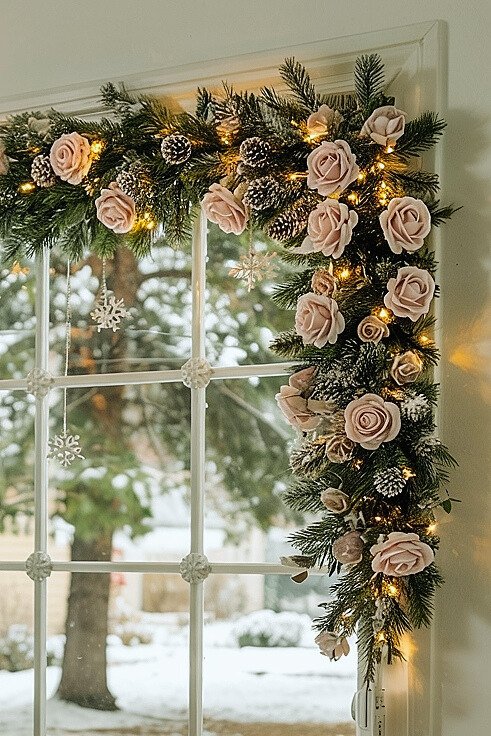
You don’t need fake snow everywhere. A few cool-tone choices and frosted finishes get you there with less mess. I pat a small amount of flocking on cedar tips only, then add clear acrylic “ice” picks deep in the greens for prismatic sparkle. Keep it light so roses remain lush, not dusted like pastries.
To thread fall into winter gracefully, blend dried elements with fresh. Lavender is the bridge. Here are florals that harmonize with it for that frosty, natural-meadow vibe.
5 Best Fall Florals to Blend with Dried Lavender
- Dried Statice (Limonium)
Statice holds color and shape for months, bringing fine, cloud-like texture that sits quietly behind roses. The papery heads catch light like tiny frost crystals, especially near micro-LEDs. I wire small tufts and tuck them near juniper berries so the textures talk to each other. Because statice is lightweight, it doesn’t pull on delicate stems or collapse in humid rooms. It’s a safe way to add volume without tipping the balance toward “too busy.” - Seeded Eucalyptus (Dried)
Dried seeded eucalyptus keeps its signature dots, which feel like miniature ornaments. The muted green-gray tone slides right between lavender and most rose palettes. I like it near frosted glass ornaments where the beads echo each other. It’s tough, forgiving, and easy to wire. Add sparingly—two or three sprigs per foot—so the look stays wintery rather than autumnal. The aroma is gentle after drying, which prevents scent clashes with fresh greens. - Dried Hydrangea Petals
Snip individual petals or tiny clusters and place them like confetti near rose cups. The petal thinness reads as frost-kissed lace, especially in pale pinks or bone whites. Hydrangea dries quickly and can crumble if handled roughly, so pre-wire on short picks and insert last. It’s an excellent way to soften transitions between big rose faces and sharper evergreens, giving the whole garland a gauzy, snow-blurred edge that feels romantic in photos. - Wheat or Oat Sprigs
For a subtle wild-meadow thread, weave in a few bleached wheat or oat stems. Keep them very short—just the heads—so they read as texture, not “harvest.” The pale gold adds warmth to cool palettes without turning the scheme rustic. I use them near ribbon loops for a delicate, unexpected wink. Because grains are stiff, wire them securely and angle slightly downward to avoid catching sleeves on mantels or stair rails. - Dried Baby’s Breath (Gypsophila)
In small doses, dried baby’s breath feels like a dusting of snow. The tiny blooms scatter light and can bridge gaps where greens feel too dark. I mist them lightly before wiring to reduce shedding. Place near lavender sprigs so the micro-textures mingle; the effect is airy, almost sparkling, without a single glitter flake. Ideal for homeowners who want a pristine look but prefer natural materials over plastic icicle picks.
Solution: Snow-light recipe
- Add minimal flocking on cedar tips.
- Use clear “ice” picks deep, not surface-level.
- Pair lavender with one dried floral from the list.
If you want to push the wonderland theme outdoors, keep reading—longevity tactics will save you rework.
Ways to Make a Christmas Garland Last Through the Holidays
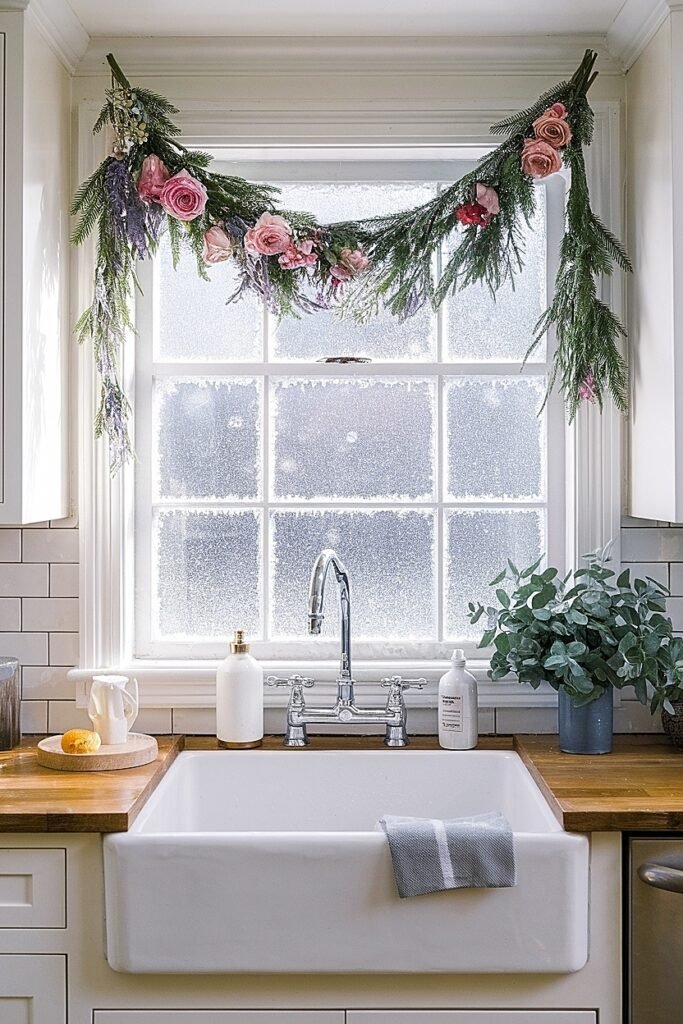
Longevity starts with prep and ends with placement. Hydrate everything. Keep stems short. Avoid heat sources. I hydrate roses overnight, then use water picks for any big heads near vents or fireplaces. Greens love a daily mist—do it early morning so surfaces dry by evening.
Environment matters. Heat blows petals open quickly; sunlight can bleach lavender. If the garland must sit above a fireplace, run the fire low and only while you’re in the room. Consider a hybrid approach—fresh focal roses for parties, preserved/faux for daily display.
Solution: My maintenance checklist
- Hydration: Overnight conditioning; water picks for focal roses.
- Misting: Light, daily, especially cedar and eucalyptus.
- Placement: Away from vents, radiators, and direct sun.
- Rotation: Swap in fresh focal roses at the two-week mark.
- Cleanup: Keep a small kit—wire, tape, spare ribbon—for quick fixes.
Conclusion
A Lavender and Rose Christmas Garland earns its praise not with more stuff, but with smarter choices. Build a strong base. Pick roses that hold. Thread in lavender for scent and line. Use lights like candlelight, ornaments like punctuation, and ribbon as mood. Keep textures in conversation and color palettes intentional. Then respect the environment and the piece will love you back all season.
I’ve used these exact moves in homes from tiny apartments to sprawling farmhouses. You can, too. Start with what you have, edit without mercy, and let the flowers speak. Your December will smell better, glow softer, and look like you planned it that way all year.
This website contains affiliate links, and some products are gifted by the brand to test. As an Amazon Associate, I earn from qualified purchases. Some of the content on this website was researched and created with the assistance of AI technology.
